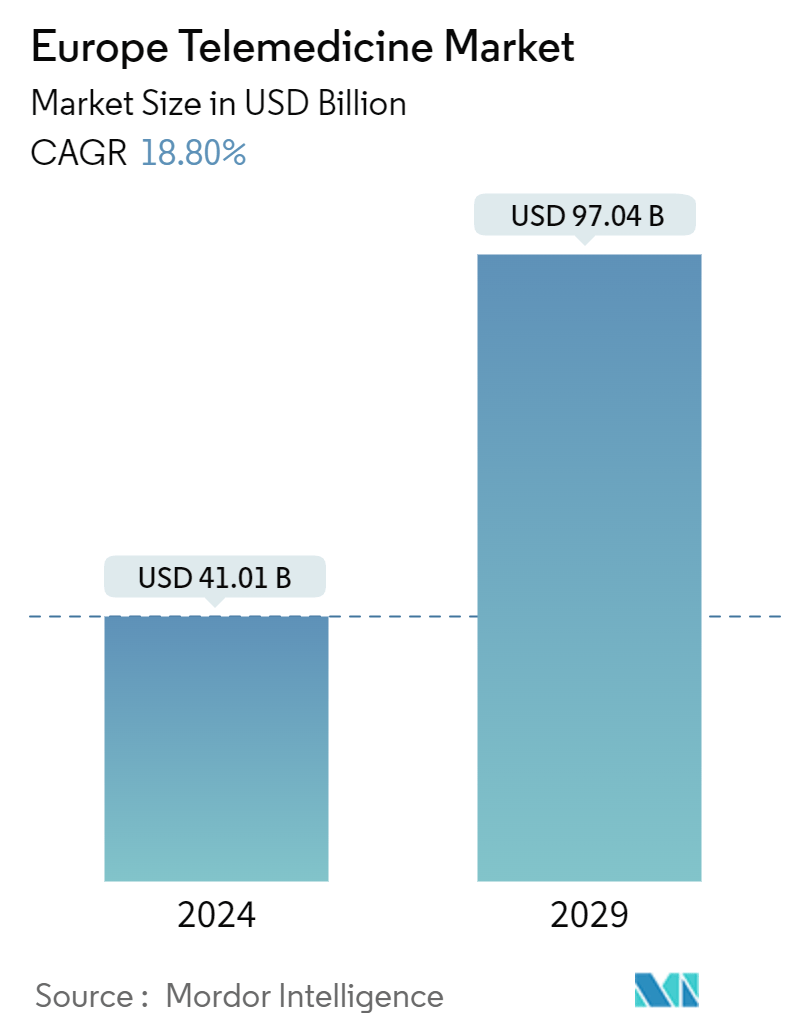Market Size of Europe Telemedicine Industry

| Study Period | 2019 - 2029 |
| Market Size (2024) | USD 41.01 Billion |
| Market Size (2029) | USD 97.04 Billion |
| CAGR (2024 - 2029) | 18.80 % |
| Fastest Growing Market | Europe |
| Market Concentration | Medium |
Major Players
*Disclaimer: Major Players sorted in no particular order |
Europe Telemedicine Market Analysis
The Europe Telemedicine Market size is estimated at USD 41.01 billion in 2024, and is expected to reach USD 97.04 billion by 2029, at a CAGR of 18.80% during the forecast period (2024-2029).
The Europe Telemedicine Market is undergoing substantial growth, driven by critical factors transforming the healthcare sector across the continent. These forces are reshaping how healthcare is delivered and addressing pivotal challenges within European healthcare systems.
Megatrends and Macro Growth Drivers: Digital healthcare transformation, the need for cost-efficient solutions, and the shift towards patient-centered care models are driving the European Telemedicine Market. These trends are intertwined with other specific growth drivers, fueling the expansion of telemedicine in Europe.
Rising Healthcare Costs: Rising healthcare expenditures across Europe are propelling telemedicine adoption. As governments increase spending to enhance healthcare standards, there is a growing demand for cost-effective solutions. For example, countries like France, Denmark, Austria, the Netherlands, and Norway allocate 8-10% of their GDP to healthcare. Telemedicine helps mitigate costs linked to chronic disease management, reduce patient travel, and shorten hospital stays, offering a practical solution to escalating healthcare expenses.
Technological Innovations: The rapid digital transformation, accelerated by the COVID-19 pandemic, is significantly impacting healthcare delivery in Europe. The European Union and member states are spearheading initiatives to promote digital health. For instance, the EU4Health program allocates €5.1 billion to support healthcare's digital evolution. Meanwhile, investments in digital health startups are surging, with over 600 funded companies active across Europe. This innovation wave enhances telemedicine’s accessibility, efficiency, and integration within healthcare systems.
Increasing Remote Patient Monitoring: Remote patient monitoring (RPM) has emerged as a valuable tool in improving disease management. Products like MicroPort CRM's Bluetooth-enabled Alizea™ and Borea™ pacemakers exemplify the technological advancements fueling RPM growth. In the UK, Smith+Nephew and Huma launched an RPM service for orthopedic surgeries, optimizing preoperative care and outcomes. These innovations improve care quality while reducing strain on healthcare systems.
Growing Burden of Chronic Diseases: Chronic diseases represent a significant challenge for healthcare systems in Europe, with telemedicine offering solutions to mitigate this burden. One-third of the European population over 15 lives with a chronic condition. Telemedicine facilitates continuous monitoring and access to care, especially for diseases like diabetes, which affects 59 million adults in Europe. The technology enables early diagnosis and personalized care, making it invaluable for managing chronic conditions across the continent.
In summary, the Europe Telemedicine Market is driven by rising economic pressures, technological advances, changing healthcare demands, and the chronic disease burden. As these forces reshape the healthcare landscape, telemedicine will continue playing a crucial role in delivering high-quality, accessible healthcare.
Europe Telemedicine Industry Segmentation
As per the scope of the report, telemedicine refers to the remote diagnosis and treatment of patients with the help of telecommunications technology. Various kinds of telemedicine services, along with devices, have been tracked in the report.
The European telemedicine market is segmented by type, component, services, mode of delivery, and country. By type, the market is segmented into tele hospitals, tele homes, and mHealth. By component, the market is segmented into products and services. By delivery, the market is segmented into on-premise delivery and cloud-based delivery. By geography, the market is segmented into Germany, the United Kingdom, France, Italy, Spain, and the Rest of Europe. The report offers the value (USD) for the above segments.
| By Type | |
| Telehospitals | |
| Telehomes | |
| mHealth (Mobile Health) |
| By Component | ||||||||
| ||||||||
|
| By Mode of Delivery | |
| On-premise Delivery | |
| Cloud-based Delivery |
| Geography | |
| Germany | |
| United Kingdom | |
| France | |
| Italy | |
| Spain | |
| Rest of Europe |
Europe Telemedicine Market Size Summary
The European telemedicine market is experiencing moderate growth, driven by the increasing adoption of digital health solutions, particularly during the COVID-19 pandemic. Telemedicine has become an essential part of healthcare delivery, facilitating the screening, diagnosis, and management of chronic diseases across the region. The market is propelled by factors such as rising healthcare expenditure, a growing preference for remote patient monitoring, and the increasing prevalence of chronic conditions. The pandemic has accelerated the use of mobile health applications, supported by regulatory bodies, enhancing the accessibility and personalization of healthcare services. Despite these advancements, challenges such as legal and reimbursement issues, high initial costs, and limited physician support pose significant barriers to market expansion.
Germany stands out in the European telemedicine landscape due to its substantial healthcare spending and a rapidly aging population, which is more susceptible to chronic diseases. The country's focus on improving care management and reducing healthcare costs through telemedicine has led to increased market activity. Vendors are actively engaging in partnerships and product launches to strengthen their market presence. The competitive landscape is characterized by both international and regional players, including well-known companies like IBM, Philips, and Medtronic. These developments, coupled with government initiatives to promote mHealth, are expected to drive significant growth in the European telemedicine market over the forecast period.
Europe Telemedicine Market Size - Table of Contents
-
1. MARKET DYNAMICS
-
1.1 Market Overview
-
1.2 Market Drivers
-
1.2.1 Increasing Remote Patient Monitoring
-
1.2.2 Growing Burden of Chronic Diseases
-
-
1.3 Market Restraints
-
1.3.1 Legal and Reimbursement Issues
-
-
1.4 Porter's Five Forces Analysis
-
1.4.1 Bargaining Power of Suppliers
-
1.4.2 Bargaining Power of Buyers/Consumers
-
1.4.3 Bargaining Power of Suppliers
-
1.4.4 Threat of Substitute Products
-
1.4.5 Intensity of Competitive Rivalry
-
-
-
2. MARKET SEGMENTATION (Market Size by Value -USD)
-
2.1 By Type
-
2.1.1 Telehospitals
-
2.1.2 Telehomes
-
2.1.3 mHealth (Mobile Health)
-
-
2.2 By Component
-
2.2.1 By Products
-
2.2.1.1 Hardware
-
2.2.1.2 Software
-
2.2.1.3 Other Products
-
-
2.2.2 By Services
-
2.2.2.1 Telepathology
-
2.2.2.2 Telecardiology
-
2.2.2.3 Teleradiology
-
2.2.2.4 Teledermatology
-
2.2.2.5 Telepsychiatry
-
2.2.2.6 Other Services
-
-
-
2.3 By Mode of Delivery
-
2.3.1 On-premise Delivery
-
2.3.2 Cloud-based Delivery
-
-
2.4 Geography
-
2.4.1 Germany
-
2.4.2 United Kingdom
-
2.4.3 France
-
2.4.4 Italy
-
2.4.5 Spain
-
2.4.6 Rest of Europe
-
-
Europe Telemedicine Market Size FAQs
How big is the Europe Telemedicine Market?
The Europe Telemedicine Market size is expected to reach USD 41.01 billion in 2024 and grow at a CAGR of 18.80% to reach USD 97.04 billion by 2029.
What is the current Europe Telemedicine Market size?
In 2024, the Europe Telemedicine Market size is expected to reach USD 41.01 billion.

